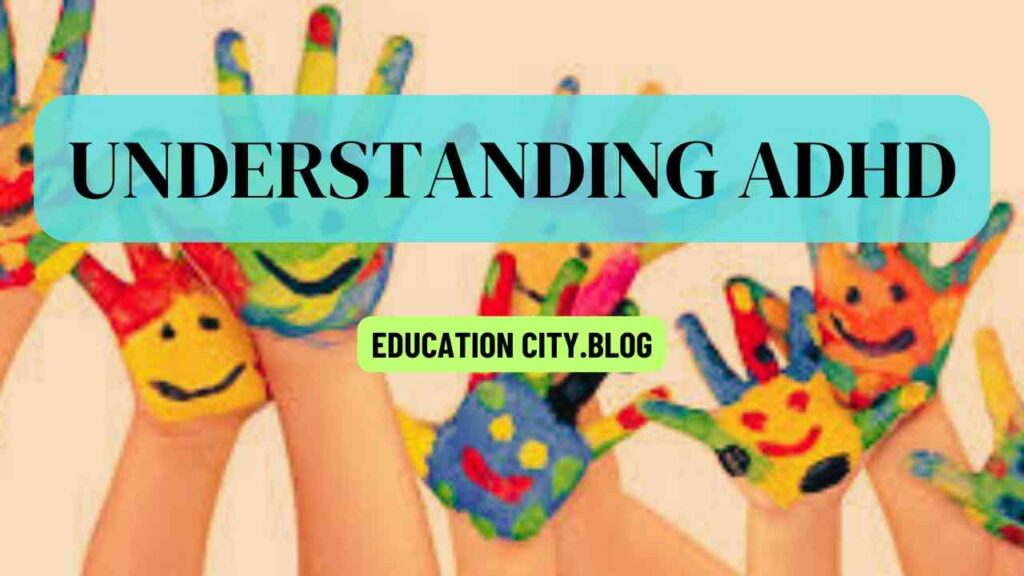Understanding ADHD :-

Understanding ADHD, Attention deficit/hyperactivity disorder (ADHD) is a neurodevelopmental condition characterized by constant patterns of inattention, hyperactivity, and numbness that significantly affect daily functioning. It is not just a lack of attention or restlessness, but includes fundamental neurological differences, especially in the regulation of neurotransmitters such as dopamine and norepinephrine. ADHD appears throughout life and varies in its presentation, some individuals primarily show inattention, while others show hyperactivity and sentimentality. Managing tasks, organization and time may be difficult for people with ADHD, but recognizing the powers associated with this condition, such as creativity and flexibility, is very important. Personal strategies, support, and understanding play an important role in helping people with ADHD go to their unique academic landscape.
Symptoms of ADHD(Understanding ADHD) :-
It is normal for children to have difficulty concentrating and behaving at some point. However, children with ADHD don’t just grow out of these behaviors. Symptoms persist, can be severe, and can cause problems at school, home, or with friends.Understanding ADHD
A child with ADHD may face
- Difficulty in maintaining focus
- Careless mistakes in works
- Forgetfulness in daily activities
- Easily distracted by irrelevant stimuli
- Excessive anxiety or restlessness
- Difficulty sitting in predictable situations
- Continuity in decision making
- Interrupting others during conversations or activities
- Difficulty waiting someone’s turn
- Poor organizational skills
- Completion of inconsistent work
- Decreased ability to listen or pay attention in conversation
- Perpetual delays or overdue deadlines
- Delay in starting work
- Difficulty estimating and managing time
Types of ADHD :-
There are three types of ADHD
- ADHD, Predominantly Inattentive Presentation (ADHD-I):
- ADHD, Predominantly Hyperactive-Impulsive Presentation (ADHD-HI):
- ADHD, Combined Presentation:
ADHD, Predominantly Inattentive Presentation (ADHD-I):
ADHD, mainly careless presentation (ADHD-I), is characterized by continuous difficulties in maintaining focus and managing tasks. Individuals with this subtype may struggle to focus on activities, which can lead to carelessness and forgetfulness. Although hyperactivity and implance may exist, they are usually less pronounced than other subtypes. Common challenges include daydreaming, being easily engaged, and having difficulties in completing tasks that require constant attention. Recognizing and understanding the unique characteristics of ADHD-I is vital to helping to develop effective interventions and address specific difficulties related to attention.Understanding ADHD
ADHD, Predominantly Hyperactive-Impulsive Presentation (ADHD-HI):
ADHD, mainly characterized by hyperactivity-impulsive presentation (ADHD-HI), hyperactivity and impulsiveness. People with this subtype are often unable to sit in restlessness, restlessness, and situations where this is expected. Apathy appears as hasty decision-making, interrupting others, and waiting for someone’s turn. Although inattention may be present, it is usually overshadowed by more significant hyperactive and impressive behaviors. Understanding and dealing with the challenges associated with ADHD-HI is very important to develop targeted interventions that help individuals manage their energy levels and emotional tendencies, promoting better functioning in various aspects of daily life.
ADHD, Combined Presentation:
ADHD, combined presentation, is the most common subtype, with a wide spectrum of symptoms including inattention, hyperactivity, and impulsivity. People with this presentation often face challenges in many areas of life. They may struggle to maintain focus on tasks, exhibit restlessness and irritability, and engage in impulsive behaviors. This combination can significantly affect academic performance, social interactions, and overall daily functioning. Recognizing the diverse nature of symptoms in ADHD co-presents is essential to developing comprehensive interventions that address the unique combination of attentional and behavioral difficulties faced by these individuals.Understanding ADHD
Causes of ADHD
ADHD may be caused by
- Genetic Factors
- Brain Structure and Function
- neurotransmitter imbalance (dopamine, norepinephrine)
- Prenatal and maternal factors (maternal smoking, alcohol consumption, preterm birth)
- Environmental toxins (eg exposure to lead)
- Low Birth Weight
- Maternal stress during pregnancy
- Parental Psychopathology
- Food Addiction and Allergies
- Traumatic Brain Injury
- Exposure to certain drugs during pregnancy
- Complications of preterm birth
- Early childhood exposure to tobacco smoke
- Increased sugar and artificial additives
- lack of breastfeeding
Diagnosis:-
Deciding whether a child has ADHD is a multi-step process. There is no single test to diagnose ADHD, and many other problems, such as anxiety, depression, sleep problems, and some types of learning disabilities, can have similar symptoms. One step in the process involves a medical examination, including hearing and vision tests, to rule out other problems with ADHD-like symptoms. An ADHD diagnosis usually involves a checklist to rate ADHD symptoms and taking a history from parents, teachers, and sometimes the child.Understanding ADHD
Need help?
If you or your doctor have concerns about ADHD, you can refer your child to a specialist such as a child psychologist, child psychiatrist, or developmental pediatrician, or you can contact your local early intervention agency (3 (for children under 1 year of age) or contact the public school. (for children ages 3 and up). The Centers for Disease Control and Prevention (CDC) funds the National Resource Center on ADHD, a program of CHADD – Children and Adults with Attention-Deficit/Hyperactivity Disorder. Their website has links to information for people with ADHD and their families. The National Resource Center operates a call center (1-866-200-8098) with trained staff to answer questions about ADHD.Understanding ADHD
For more information you can check
http://www.help4adhd.org/NRC.aspx
http://www.nimh.nih.gov/health/topics/attention-deficit-hyperactivity-disorder-adhd/index.shtml

Pingback: Parenting a Child with ADHD: Nurturing Brilliance EducationCity.Blog